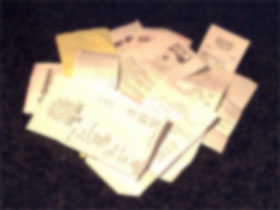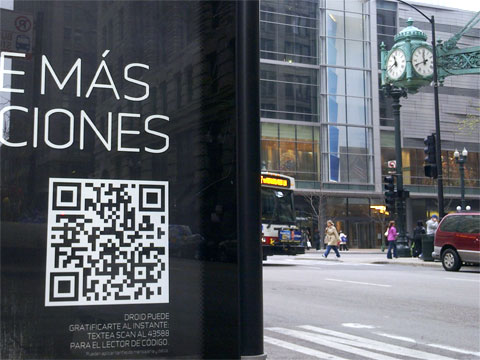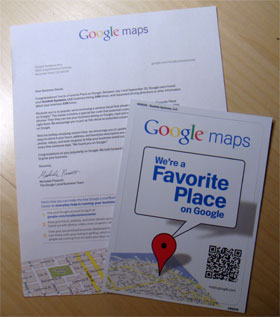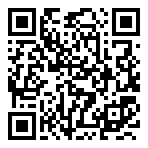Ideas To Eliminate And Automate Retail Receipts
 Although I don’t want to come off as repeating myself, paper retail receipts are out of hand. Where such receipts are important and necessary in documenting financial transactions, they can also become a cumbersome mess that can easily get out of control. Now some of you reading this may think I am going to an extreme, and you may not even save and reconcile to receipts. But I always have personally, and I have to for my Web consulting business, as any business owner should.
Although I don’t want to come off as repeating myself, paper retail receipts are out of hand. Where such receipts are important and necessary in documenting financial transactions, they can also become a cumbersome mess that can easily get out of control. Now some of you reading this may think I am going to an extreme, and you may not even save and reconcile to receipts. But I always have personally, and I have to for my Web consulting business, as any business owner should.
Here are a few more ideas I have regarding receipts, which build upon my initial rant conversation on retail receipts. As I don’t have the time, money or energy to act on these right now, I put these out there for anyone to take a stab at. Even if someone is successful and becomes a billionaire with some of them, it will eventually make my life easier!
Receipt File Format Standard – Call it the vCard or iCal standard for retail receipts. This would me an XML file structure for storing all of the data of a receipt into a file. This file will be in lieu of a paper receipt, and identifiable to the retailer by a unique serial number… which most receipts have today anyway. For the sake of discussion here, let’s call it vReceipt.
Deliver vReceipt files by SMS, Email or Web – Once a retailer creates a vReceipt, it needs to get to the customer. It could be delivered to them by any number of methods. If a customer provides their mobile number, it could be sent by SMS. If they provide their email, it could come in a message. The retailer could create a custom QR code for the transaction, and upon the customer scanning it, they could download the vReceipt from the Web. If the customer has a “membership” account with the retailer, the receipt could be delivered via their Web site.
Retailer transmits vReceipt data to third-party service via app – Why not have an app for that? When you check out, your app can show a QR code which can be scanned, then the retailer would transfer the receipt to the 3rd-party service. This service could be Quicken or your bank or a new service you use to track expenses.
Processing vReceipts Makes Expense Tracking Easy – Even though services like QuickBooks Online already sync with your bank, vReceipts can break down the transaction onto its pieces. Were 7 items purchased for work, one was a gift and the rest for the house? A vReceipt will know what was purchased, and will pre-populate the category of an item, or accept whatever override you have for it.
vReceipts App Can Be Used for Returns, Exchanges and Taxes – vReceipts should not just be for figuring out how much you spent on Pringles last year. As a replacement for paper, they should carry all the weight and responsibility of their soon-to-be-defunct paper counterparts. The identifiable information from the retailer should suffice for returns, exchanges, as well as proof for expenses for tax purposes. They would ideally replace having to fax receipts to your employer after you submit your expense report online as well.
What do you think of my ideas around vReceipts? Feel free to compliment, tear apart of use for your own, and your comments are welcome here, which along with vReceipts won’t consume any paper.
This is from The Hot Iron, a journal on business and technology by Mike Maddaloni.
Did you enjoy this? Subscribe to The Hot Iron by RSS/XML feed or Read by Email.
Business • QR Codes • Strategize • Technology • Web Development • (6) Comments • Permalink
New And Old Retail Meet Via QR Codes
Walking to the office today something caught my eye that I had to share, as pictured below.

Across from the former Marshall Field’s department store in Chicago on Washington Street is a bus stop. On that bus stop is an ad in Spanish for Google Android mobile phones. Prominent in the lower right corner of the ad is a QR code. What got my attention was the contrast of the old vs. new retail. The Field’s building, over a century old, with its iconic clock in comparison to the QR code on a non-English ad for a mobile device from a vendor barely over a decade old.
The real question is if these will continue to be 2 completely different retail concepts, or if they will come together as one?
Did you enjoy reading this? You are welcome to subscribe to The Hot Iron by RSS feed or by email.
Google Promotes Maps and Local Listings With Decals and QR Codes
 It’s not everyday that someone says you’re a favorite, especially when that someone is Google.
It’s not everyday that someone says you’re a favorite, especially when that someone is Google.
Yesterday I received a letter from Google’s Local Business Team regarding my Internet consulting firm, Dunkirk Systems, LLC. It stated my Google Local listing is a “Favorite Place of Google” and reinforced this with stats – it was viewed 346 times in the 3rd quarter of 2009. Along with this letter of praise came a window decal stating “We’re a Favorite Place on Google” which features a QR code with a link to the mobile version of my Google Local listing. If you have a QR code reader on your mobile device, click on the accompanying photo to see a larger version of it from which you can scan the QR code and navigate to the link, or view the link to my mobile listing in your Web browser.
Where I haven’t done any poking around to see who else got a similar letter, there is some value in this, and just the opposite. First off, Google Local listings work. I have been seeing the hits coming to the Dunkirk Web site from the Local listing in my Google Analytics reporting. It is also yet another way to drive traffic to you and your business. Google Local also gives the ability for people to rate a business, similar to Yelp, which also provides businesses with window stickers.
For a retail establishment, this is a great program to offer the window stickers. But for a business like mine, it isn’t something I can leverage. First off, my mailing address is different from my office location. And my office isn’t typically where I meet my clients or have walk-in traffic. But Google Local doesn’t know this, nor did they ask.
Legendary US Congressman and House Speaker Tip O’Neil is known for his quote, “all politics is local.” Can the same be said for search? Yes and no, with an emphasis on the word “and.” If you don’t have a Google Local listing for your business, set one up right away. Today, there’s many services offered by Google, at no cost, that businesses and Web sites must use. So it’s quite obvious I use them myself, and do business with Google in many ways. Whatever your opinion of them, keeping up with what is offered by the Internet giant is vital.
Business • Mobile Technology • QR Codes • Technology • (1) Comments • PermalinkTesting Mippin To Mobilize The Hot Iron
 Mobile devices are the next frontier of the Internet. Where companies and even governments are now battling it out over the desktop, it is the device you can fit in your pocket that will be the next place they will be after. Where those reading this who live outside of the US are very in tune with this, folks here are not so much aware of this, namely as mobile devices are now crossing over from being simple phones to smartphones.
Mobile devices are the next frontier of the Internet. Where companies and even governments are now battling it out over the desktop, it is the device you can fit in your pocket that will be the next place they will be after. Where those reading this who live outside of the US are very in tune with this, folks here are not so much aware of this, namely as mobile devices are now crossing over from being simple phones to smartphones.
Now I will step off my soapbox and talk about practical applications, which is the path to the success of conquering the mobile frontier. When I recently happened upon Mippin, a service that will format your blog to display on a mobile device, I had to try it out. By creating a free account and entering my blog’s URL, it created an optimized version of The Hot Iron for a mobile device. You can see this for yourself by clicking the widget above or click this link. You are sent to a page to display it on your device, whether by entering a URL manually of scanning a QR code. As it is a Web page, you can display it in a standard Web browser as well.
Eventually I plan to build my own mobile-optimized version of The Hot Iron, but for now this is a good stand-in for it. I welcome your input on how this mobile format looks and works for you.
Did you enjoy reading this? You are welcome to subscribe to The Hot Iron by RSS feed or by email.
Earth Day and QR Codes
 Happy Belated Earth Day 2009! You either scrambled to do something “green” or wondered what more you can do, as it seems you are living about as green of a life as possible. I took a few moments to think about my day-to-day actions and how they impact the big picture of the world, and one word came to mind – innovation.
Happy Belated Earth Day 2009! You either scrambled to do something “green” or wondered what more you can do, as it seems you are living about as green of a life as possible. I took a few moments to think about my day-to-day actions and how they impact the big picture of the world, and one word came to mind – innovation.
The Usual Suspects
As I have previously stated here on The Hot Iron I try to be as aware as possible as to my environmental impact. I wrote what I do in a draft environmental statement for my consulting firm Dunkirk Systems, LLC though I never got any feedback and it still has not reached Dunkirk’s Web site. I also carry a Reisenthel bag with me everywhere I go. Based on these, I feel I am doing as much as I have control over to do.
Other than these actions, making a greater impact takes more work, and that’s where I feel innovation comes into play. When thinking about it more, another thing came to mind – QR codes.
What are QR Codes and Why Should I Care
QR stands for “quick response” and a QR code is a 2-dimensional barcode in the form of a cube. With 2 dimensions, it can store a larger amount of information than a traditional 1-dimensional barcode (e.g. UPC code on a product). As a result, you can store whole sentences of information, Web site URLs, email addresses and even entire contact information records. For example, the accompanying QR code in this post reads, “Happy Earth Day 2009 from The Hot Iron @ thehotiron.com !”
So how would you know that? QR codes are read by a scanner, and the most common form of scanner is a camera on a mobile device with accompanying software. Most Nokia models come preinstalled with a reader, otherwise you can get one from i-nigma among other vendors. Many devices are supported with a notable exception in Palm OS devices.
When the QR code is scanned, the information stored in the QR code is transferred to the mobile device, and you can then process it. If it displays text, you can read and save it. If it’s a URL, you can then browse to it. If an email address, you can send a message to it. If it’s contact information, you can add it to your contacts. This is basic usage of it. With more advanced software, you can do almost anything.
The following is a popular YouTube video from Japan showing how you can get nutritional information for McDonald’s menu items if you can’t see it you can view it here.
Tying The Message Together
As you may guess, QR codes are popular in Asia and in Europe but are still emerging in the US. I see QR codes as an innovative way to effectively communicate and reduce waste and costs at the same time. QR codes only require energy when they are scanned, and by the scanner themselves. They are also more eco-friendly than an RFID tag that require special manufacturing as well as are more cost effective. Here are a few examples of "green" uses that come to mind.
- Subway ads feature a QR code, eliminating the need to have tear-off postcard pads attached to them, or the need to write down information and hard-to-remember URLs.
- For that matter, all advertising should have a QR code with whatever desired call to action the advertiser desires.
- At networking events or conferences, people can wear name badges sporting QR codes with their contact information. This eliminates the need to print and carry business cards, and reduces the time to process information from those cards.
- At the Lollapalooza festival this year in Chicago, replace giving out cards on lanyards with people scanning QR codes to get free songs from iTunes, and they could be downloaded right to your device bypassing the iTunes computer software (with a more robust scanner software).
Where Earth Day continues to be popular, for many it is a day to make symbolic gestures. New, fresh and innovative ideas are needed to reinvigorate it, and QR codes fit the bill. What say you?
Did you enjoy reading this? You are welcome to subscribe to The Hot Iron by RSS feed or by email.



